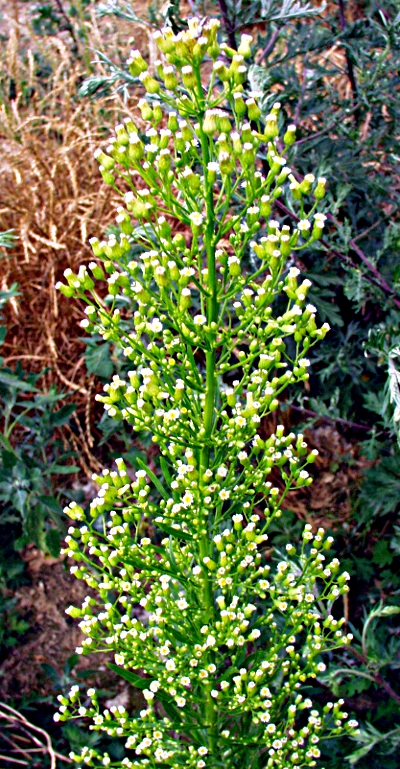Conyza, horseweed |

Because of the bushy growth habit in the area of the flower heads Conyza canadensis is also called "marestail"
Konyza first appears at Theophrastus, who differed a male and a female species. It is not entirely clear which plants he meant, but they are presumed today in the genera Inula or Erigeron. Etymologically Konyza could be a combination of gr. Konis (dust) and gr. Coryza (cold), may be because the pollen often cause hay fever. The name "marestail" refers to the entire plant, with its often bushy growth.
Plants of this genus as well as representatives of Erigeron are called in English "fleabane". The reason for this is, that Conyza was formerly incorporated in Erigeron or was merely regarded as a section of Erigeron. The common name refers to the fact that the plant is said to be able to dispel fleas.
Comprising more than 60 species, the genus occurs in all subtropical and warm temperate regions of the earth. Fleabanes are annual to perennial herbs with taproots or shrubs or small trees. The most upright stems are bristly or glabrous and usually, at least in the upper region, branched. The basal leaves are mostly missing in the flowering season. The stem leaves are stalked or sessile, sometimes amplexicaul, alternate, pubescent, oblong, linear or lanceolate with entire, toothed or pinnatifid lobed margins.
The rayless or short-rayed flower heads are rather small and stalked. They are arranged individually or generally for a few or many in panicled or corymbose inflorescences. The receptacle is flat or curved, pitted or smooth and without chaffy leaves. The turbiniform, urn-shaped or bell-shaped involucre consists of 2–4 rows of more or less scale-like arranged phyllaries, which are lanceolate to linear and often curved sideways. The outer ones are shorter than the inner phyllaries.
The female ray florets are either white to purple, usually arranged in 1 to 2 rows and have filiform to elliptical ligules that are shorter than the corolla tube, or they are standing in 2 to 5 rows, have a yellowish colour and no tongues. The central disc flowers are hermaphrodite or male, yellowish and mostly 5-toothed. Mostly, the ray florets are much more numerous than the disc florets.
After self or insect pollination the inferior ovary forms an up to 2 mm long, usually finely hairy nut fruit (achene), which is oblong-elliptic, sometimes flattened and at the apex with a circle of fine, usually brittle, bristly, up to 3 mm long sailing hairs (pappus). The fruit is spread by the wind.
| General floral formula: |
| *–↓ K=pappus [C(5) A5(connate)] G(2) inferior |
The two genera Erigeron and Conyza are morphologically hardly to separate, both are also not monophyletic. Also another satisfactory classification of the genera does not seem to be possible. Surely it would be more advantageous, to accommodate both genera in a larger genus Erigeron, as it has already been practiced in the past.
Meaning of the species name
- canadensis: lat canadensis = canadian
Interesting notes
Representatives of this genus are originally not indigenous in Europe but were introduced from North America.
Conyza canadensis is nontoxic and edible. The dried herb can be used as sweat inducing tea against diarrhea, and the young leaves may be added to a salad.